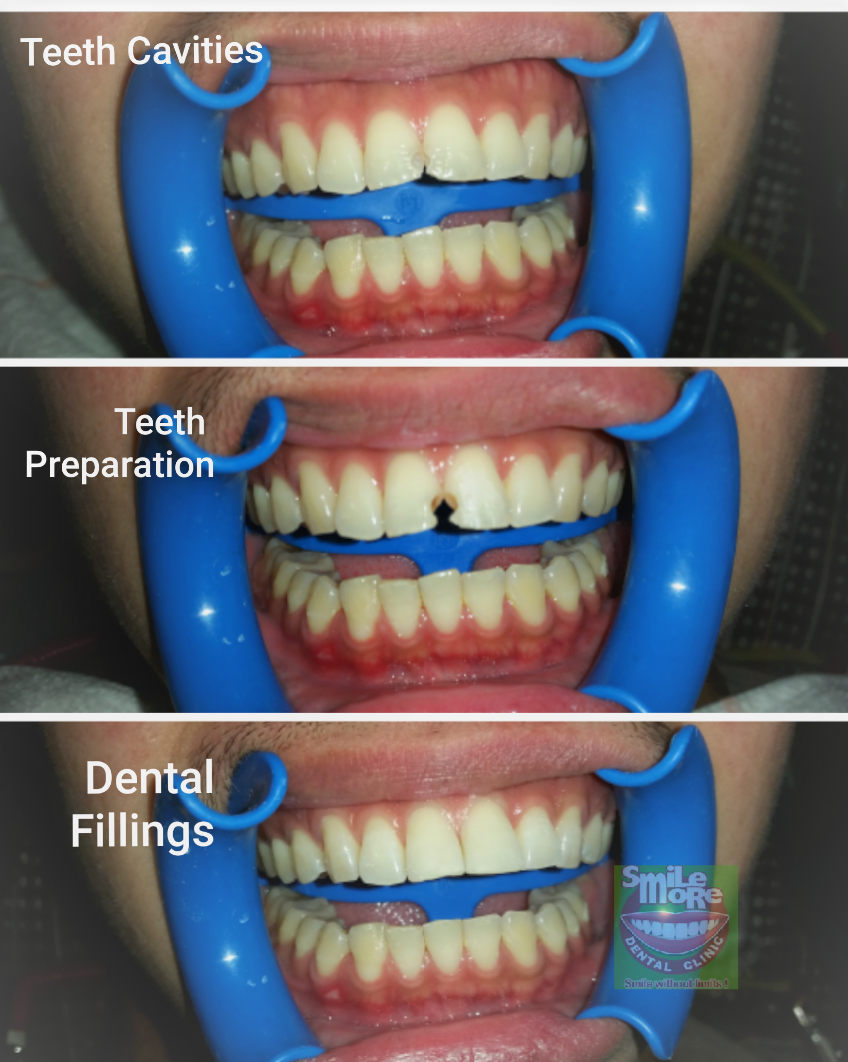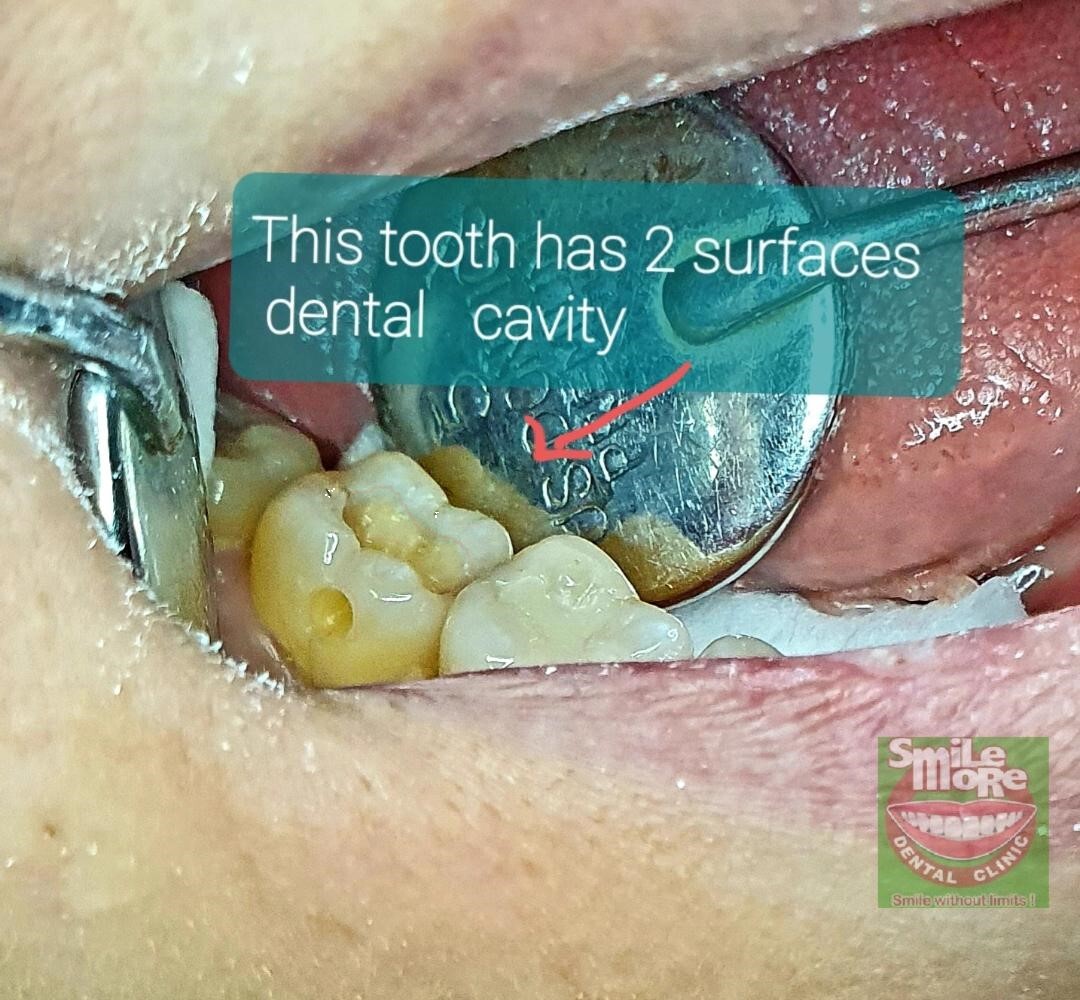Dental Fillings
The most common service done in our clinic is dental fillings. They are intended to restore or repair the decayed, damaged, or chipped tooth into a healthy and functional form, as it was before.

We can repair a broken or dislodged filling, like in cases of recurrent decay. Still, a careful review of the tooth’s health status and vitality is essential if saving the tooth and avoiding future problems is the goal. For broken fillings, time is crucial because the longer you wait, the less chance for better tooth mending.
How do we do Dental Filings?
1.) Checking and evaluating each tooth to be filled whether dental fillings are a suitable solution. We require X-rays if restoring multiple teeth or for questionable teeth status.
2.) Typically for shallow and superficial dental cavities, local anesthesia may not be necessitated. For deep and complex tooth decay, or when the patient is not comfortable – we can put the tooth to numb.
3.) We prepare the tooth to receive a dental filling, carefully removing the blackened or decayed part. We emphasize doing this part because just preparing the tooth without really removing the rottenness will not treat the decay. Bacteria can still eat up the underlying structure and eventually recur into a more extensive decay and tooth disintegration. A learned dentist knows that the cavity preparation design box should incorporate a retentive design for the dental filling to be holding efficiently.
4.) When we are sure that all the decay is removed, we wash and clean the prepared tooth using a water syringe, then dry it.
5.) Suppose the prepared hole is shallow. We apply an etching solution that will do micro-holes on the borders of the preparation for added tooth filling retention. This solution does not have a pleasing taste, and sometimes you taste them by chance. Just spit it away, do not swallow, and we will wash it out anyway.
6.) A deep and complex dental cavity requires inner protection. We all know that the tooth is a living tissue that can sense pain or sensitivity. This is when we put a nerve protection, called cavity base. The reliability of the finished dental filling will rest on the condition that future distress can be avoided if the inner structure has been protected. Using this added dental material will safeguard the underlying nerve, so we emphasize that they be put if required.
7.) Using a special glue called a bonding agent, we apply this to the prepared surface, and then we use a Light-cure device that makes it bonded to the tooth. This is the lock that secures the filling to the tooth, as you might wonder why the dental filling is gripped that way to the repaired tooth.
8.) The bulk of the filling is the Composite Resin material or the Tooth-Colored Filling that we customarily use. We have to be sure that they are adequately packed, with no voids underneath, and sealed accordingly. Again, the Light-cure emitting light device will cause this filling to harden.
9.) We require a molder or thin metallic matrix band for molars for complex dental cavities when using Amalgam Fillings and Celluloid Strips when using Composite (White) Fillings. This is essential for good packing and avoiding the filling from sticking to the adjacent teeth for Composites.
10.) We aim to always put the dental filling material on the tooth without saliva contamination. We very well know that bacteria from the saliva can be incorporated into the process. So, aside from the saliva suction machine, we put a cotton roll next to the tooth being filled in.
11.) Finally, using a thin carbon paper mark indicator, we check for the correctness of the bite. Excess or high portions must be trimmed and polished as it can take a toll on the longevity of the dental filling. Polishing the completed filling is essential so that the tongue will not feel some nuisance when it passes through the filled tooth.
Having read the description above, you might agree that requiring a dental filling is no simple task. The experienced dentists of Smile More Dental Clinic (Manila), equipped with knowledge and understanding of the tooth condition, will further explain if dental fillings are a treatment option. For sure, they will advise you if this is the ideal solution for your situation.
Composite Dental Fillings – These are the commonly used dental fillings we offer in our clinic. The above description is particularly applicable to this type of dental filling. It is generally done in one visit. When choosing this option, one thing to consider is enough or substantial tooth structure to carry the load of restoration material. However, there are limits on how many dental cavities we can cover during the patient’s visit. Depending on prior agreement, patient’s tolerance, available time, budget consideration, and other factors – we can do a minimum of 2 dental fillings or more.
The durability and toughness of this filling will depend on a lot of factors:
(2.) the quality of dental filling materials being used (which you can count on us, as we continually invest in tried and tested brands);
(3.) The tooth’s condition, whether highly savable or marginally risked;
(4.) food consumptions habit of the patient (sweets, candies, junk foods, hard foods, etc.) are known to jeopardize dental fillings permanency;
(5.) and fewer accidents that possibly can happen.

The price for dental fillings at Smile More Dental Clinic in Ermita, Manila, depends on the extent of the dental cavity to be done. We usually charge them on a per surface basis. We mentioned above that we sometimes use a cavity base (or cavity liner) on deep cavities to protect the sensitive part of the tooth. If needed, we use them with extra cost.
We always recommend taking an X-ray when restoring a tooth cavity, especially the deeper ones. We need to assess how far they have affected the tooth or how close to decay has gotten near the dental nerve. With X-ray as a guide, it gives us more precision on preparing the teeth and caution not to involve the nerve.
Fixing a cavity from a filling and fixing it, again and again, is not a long-term solution. Some huge dental fillings fail, and more cavities will be gained if left that way. Because as the hole gets bigger, the remaining tooth structure becomes a lot weaker or brittle. Asking us to put a dental filling when it is not advised is never encouraged because you will only postpone the damage and the problem.
Amalgam Dental Fillings – this is the type of dental fillings that were popular back then. We had the experience of doing them, and based on what we have observed — they can survive for many years. We still see them among patients. There is a controversy on mercury being unsafe and some undesirable effects of Amalgam Fillings. But in hindsight, Amalgam Filling is not the mercury itself – it is a mixture of metal alloy and mercury mixed, and excess mercury is taken out. Amalgam fillings are known for their ease of use, strength, durability, and longevity; that is why this was the standard before and are still used in some places.
Inlays and Onlays – some occasions may require this type of solution for filling the tooth. If the prepared dental cavity is huge and putting a Composite Dental Filling is an unlikely option, this is where we offer this choice.
An inlay is intended for moderately-sized or even bigger cavities, with a remaining tooth wall of the prepared cavity that will contain it. While the inlay can extend to even more extensive damage, even involving the lost wall of the cavity and tooth cusps (the pointed part that hits the opposing teeth for chewing, usually subjected to high stress).
If the damage is too severe, it is more practical to opt for a dental crown for a reliable outcome.
Inlays and Onlays come in different forms: Ceramics, Metal, or Gold.
To do them, we require a minimum of 2 appointments. The preparation can be almost similar to how we do an ordinary dental filling, with slight variation. This type is more expensive than Composite Filling because of the cost and customization required. We will make a mold of the mouth to capture the prepared tooth in detail. We will send them to the dental laboratory for fabrication. We need to wait for their return once completed by the technician.
Because we always want to provide patients with a feasible solution, we sometimes do “Indirect Pulp Capping.” The purpose is to keep the tooth nerve vital or alive. This is possible when the bacteria has not reached or infected the dental nerve yet. We put a medicament and used a definitive or provisional filling, observing the repaired tooth for a given period, then replacing it with a durable filling material.
Temporary or Provisional Fillings – this is the material we advise to use if the dental cavities are too deep, that it is almost reaching the nerve. This cement- medicament has a therapeutic effect on the irritated tooth nerve, preventing dental pain and tooth becoming infected, which may require other services, like Root Canal Treatment or Extraction. There is, however, no guarantee if this treatment can keep the badly damaged tooth from becoming infected. Despite our best effort to preserve the tooth, if the dental nerve is already involved or bacteria has gotten their way inside, the tooth filling can eventually fail.
You have to be on guard against your dental health issues, especially tooth cavities. The sooner you see us for assistance, the bigger chance you have to save your valued teeth.
Noticeable holes or pits on the tooth’s biting surface
Mild to moderate teeth sensitivity
Tounge notices sharp area where food particles get stuck in
Uneven discoloration on teeth surface or old fillings (recurrent decay)
Toothache that happens without apparent cause
Abrasions on the neck-line of the tooth, sometimes caused by improper brushing
Mild to acute pain when drinking or eating
Food particles often getting caught in the same area.
When Do I Need a Teeth Filling?
Patients need a dental filling when bacterial tooth activity damages or rotten their teeth. Since dental cavities are dental problems created by bacteria found in plaque (they are also responsible for tartar formation) that gather on and around the tooth. These microbes flourish on sweet foods that we consume. If not adequately cleaned or removed by tooth brushing, bacteria secrete an acidic substance that weakens the tooth’s hard covering — creating a hole or cavity in the tooth. If not treated, they can eat up more teeth surfaces until sensitivity or discomfort is experienced. Compared to other dental services, this one is considered a cheap and affordable dental clinic’s service.
Dental caries usually never felt sensitive or incite pain when tooth decay is still shallow. That is why many patients don’t even realize that they have an ailing tooth until later, in the further advanced stage of tooth decay, when the hole gets deeper. Cavities start to form in places where food debris gets trapped, such as the teeth’ irregular pits, or gaps between teeth, making them even harder to detect. Frequent dental visits allow the dentist to check and spot tooth decay in the initial stages, allowing us to treat the problem before they cause severe destruction on the teeth.
Likewise, for kids and some adults, we advised that these “pits & fissures” cavity-forming occurrence be controlled by using preventive “dental sealants” that our clinic also advocates using.
Why is it necessary to fill up tooth decay with a tooth-filling material?
If left unattended, dental cavities will progress and continue to destroy the remaining tooth structure. As it goes, the decayed tooth part will more so be exposed to food particles getting caught in the decay, allowing more bacteria and food debris to thrive. The spread of the damage can involve:
- The enamel (outermost covering of teeth).
- The dentin (the second tooth layer that has nerve endings).
- The dental pulp (inner tooth nerve).
When the dental pulp becomes irritated, intense toothache becomes a daily occurrence. It can only be resolved through a Root Canal Treatment, which is a lot more costly than a dental filling or tooth extraction, resulting in tooth loss.
Patients are advised to have their dental cavities filled the soonest to stop them from spreading to nearby or adjacent teeth. Tooth decay is a disease process caused by bacteria with acidic tendencies creating decay or holes to the predisposed teeth.
What can I expect when getting a Dental Filling? Will it Hurt?
Some level of discomfort will have to be experienced when receiving a dental filling. For shallow dental decay, usually, no sensitivity to the procedure is felt. Each patient has a varying degree of tolerance to getting the tooth prepared, cleaned, and decay removed. We have noted that most patients find the tooth drilling bearable, depending on the patient’s depth of decay and pain threshold, as this may vary. A local anesthetic is available on request of the patient for pain-free dental filling treatment.
How Many Years Do Fillings Can Survive?
Dental fillings are not meant to last forever and will need to be replaced. A usual Composite Dental Fillings materials (tooth-colored) may last up to 5 to 7 years or more before being replaced. Silver Amalgam Fillings last longer, up to 10 years or more, before needing to be replaced. But in our clinic, we noticed that patients who frequently see us for a regular check-up could keep their dental fillings much longer because we can give them a quick fix when we notice some level of deterioration.
Inlays and Onlays can last the longest with proper dental care, lasting up to 10 years or more before needing replacement.
*Above figures are only estimated and do not reflect all cases. Each patient and their situation is different. As such, the lastingness of which how long each filling may endure will differ from patient to patient.
Reasons for Replacing Previous Dental Fillings:
- Failing or broken-down filling
- Discolored and tarnished filling
- Recurrent decay
